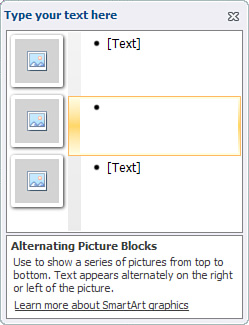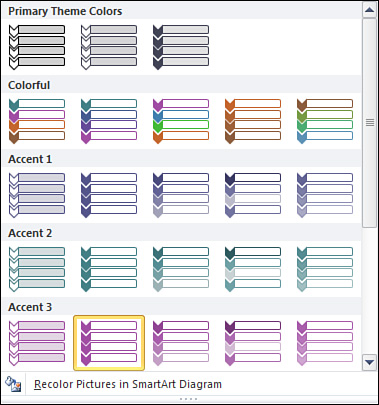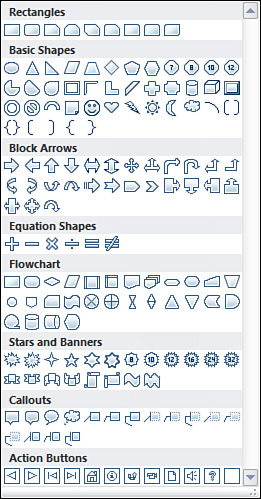PowerPoint offers two
contextual tabs that enable you to modify the design and format of your
SmartArt graphics: the SmartArt Tools—Design tab and the SmartArt
Tools—Format tab.
Note that these contextual tabs appear only when a
graphic is selected. If they disappear, select your graphic again to
view them. Also, be aware that depending on your choice of SmartArt
graphic, not all options will be available on the SmartArt Tools tabs.
|
You can also apply animation effects to your SmartArt graphics, such as having the graphic fly in to the slide.
|
Using SmartArt Design Tools
The SmartArt Tools—Design tab, as shown in Figure 1,
enables you to create additional graphic objects, specify layout and
style options, and convert your SmartArt graphic to other formats.

Adding Shapes
Although SmartArt graphics already contain shapes by
default, you can add more shapes if you need. For example, you could
create a basic cycle graphic, which comes with five shapes, and then
decide you need to add a sixth.
Adding a Shape to a SmartArt Graphic
To add a shape to a SmartArt graphic, follow these steps:
1. | Select the SmartArt graphic to which you want to add a shape.
|
2. | On the SmartArt Tools—Design tab, click the down arrow to the right of the Add Shape button to display a menu of options.
|
3. | Select from the following menu choices:
- Add Shape After— Add an identical shape after a selected shape.
- Add Shape Before— Add an identical shape before a selected shape.
- Add Shape Above— Add an identical shape above a selected shape.
- Add Shape Below— Add an identical shape below a selected shape.
- Add Assistant— Add an assistant shape to an organization chart.
|
|
The
options available are based on your choice of SmartArt. For example,
the Add Assistant menu option is available only if your graphic is an
organization chart.
|
If you want to place an additional shape in the
default location for your graphic type (such as at the end of a list),
you can click the Add Shape button directly, without viewing the menu
options.
Adding Bullets
If your SmartArt graphic supports bulleted lists, you
can add a text bullet by clicking the Add Bullet button on the SmartArt
Tools—Design tab. You must select a specific graphic object for this
button to become active.
Using the Text Pane
Although you can enter text directly on your SmartArt
graphic, using the Text pane is a good idea if you have a lot of text
or your graphic is more complex.
To open the Text pane, click the Text Pane button on the SmartArt Tools—Design tab. Figure 2 shows a sample Text pane.

In this pane, you can enter and revise text, use the
buttons in the Create Graphic group to promote or demote objects, and
edit any pictures if you selected a graphic type that includes pictures.
To
close the Text pane, click the Close button (x) in the upper-right
corner or click the Text Pane button on the SmartArt Tools—Design tab
again, which acts as a toggle.
Organizing SmartArt Content
The Create Graphic group on the SmartArt Tools—Design tab
also includes several buttons that help you organize the content in
your graphic. For example, you can promote, demote, or reorder objects
to customize your graphic exactly the way you want. Be aware that like
other options on the SmartArt Tools—Design tab, the availability of
these buttons depends on your graphic type and what object is selected.
The buttons include
Promote— Move selected object up a level. You can also use this with the Text pane.
Demote— Move selected object down a level. You can also use this with the Text pane.
Right to Left— Change layout from the right to the left.
Reorder Up— Move selected object up in a sequence.
Reorder Down— Move selected object down in a sequence.
Layout— Modify the layout of an organization chart, such as displaying subordinates to the left or to the right.
Modifying Your SmartArt Layout
The Layouts group on the SmartArt Tools—Design tab
offers several layout options that you can apply to your SmartArt
graphic. Three options appear on the tab itself, but you can click the
down arrow to the right of the group to open a gallery of additional
options. Pause the mouse over each option to preview it on your slide.
These layouts correspond to the layouts that appear on the Choose a
SmartArt Graphic dialog box.
Changing SmartArt Colors
If you don’t like your graphic’s default color
scheme, you can quickly change it by clicking the Change Colors button
on the SmartArt Tools—Design tab. Figure 3 shows the gallery that displays, offering color choices suited to your specific SmartArt graphic type.

You can choose a primary theme color, select something more colorful, or opt for one of your theme’s accent colors.
Applying a SmartArt Style
If you want to quickly dress up your SmartArt
graphic, apply one of the many ready-made styles designed to complement
your presentation’s theme. To do so, select a style in the SmartArt
Styles group on the SmartArt Tools—Design tab. For more options, click
the down arrow to display a gallery where you can chose a style that’s a
good match for your document, or try out a 3-D style.
Resetting a SmartArt Graphic
If you’ve made a lot of changes to your SmartArt
graphic and decide you don’t like what you’ve done, on the SmartArt
Tools—Design tab, click the Reset Graphic button. PowerPoint deletes all
the formatting changes you’ve made to your graphic and restores its
original format. PowerPoint doesn’t delete any text you’ve added,
however.
Converting a SmartArt Graphic
If you decide that you don’t want to use a SmartArt
graphic you created but would like to retain your text as a bulleted
list, on the SmartArt Tools—Design tab, click the Convert button, and
select Convert to Text from the menu.
Another
option is to convert your SmartArt graphic to a shape so that you can
take advantage of shape-formatting options. To do this, on the SmartArt
Tools—Design tab, click the Convert button, and then select Convert to
Shapes from the menu.
Formatting SmartArt Graphics
The SmartArt Tools—Format tab, as shown in Figure 4, offers numerous SmartArt formatting options, many of which are shared with other PowerPoint objects.

On this tab, you can
Edit a 3-D graphic in 2-D.
Format and change individual SmartArt shapes.
Apply shape style, fills, outlines, and effects.
Apply WordArt styles, fills, outlines, and effects to SmartArt text.
Arrange SmartArt objects, such as moving objects forward and backward and aligning, grouping, and rotating objects.
Change the height and width of your SmartArt graphic by clicking the Size button.
Editing in 2-D
If
you applied a 3-D style to your SmartArt graphic, you can temporarily
return to 2-D to edit it by clicking the Edit in 2-D button on the
SmartArt Tools—Format tab. When you finish editing, click this button
again to return to your 3-D style.
Changing the Appearance of SmartArt Shapes
Although SmartArt graphics include default shapes,
you might prefer a different shape. For example, if you select a Basic
Block List, your graphic includes several basic rectangles. Your
preference, however, might be rounded rectangles.
Changing SmartArt Shapes
To change the appearance of the shapes in your SmartArt graphic, follow these steps:
1. | Select
the shape or shapes you want to change. To select multiple shapes,
press the Ctrl key while clicking the shapes you want to change.
|
2. | On the SmartArt Tools—Format tab, click the Change Shape button. A gallery of shape options appears, as shown in Figure 5.

|
3. | Select the shape you prefer to change your selected shapes.
|
Resizing Shapes
If you want to resize
selected shapes on your graphic, click either the Larger or Smaller
button on the SmartArt Tools—Format tab. You can continue clicking these
buttons until you reach your desired size.